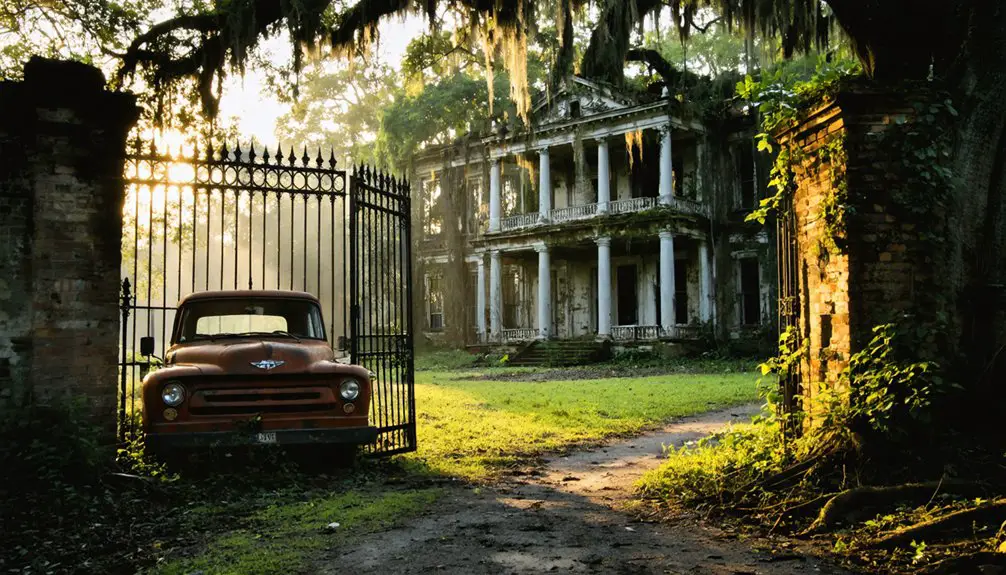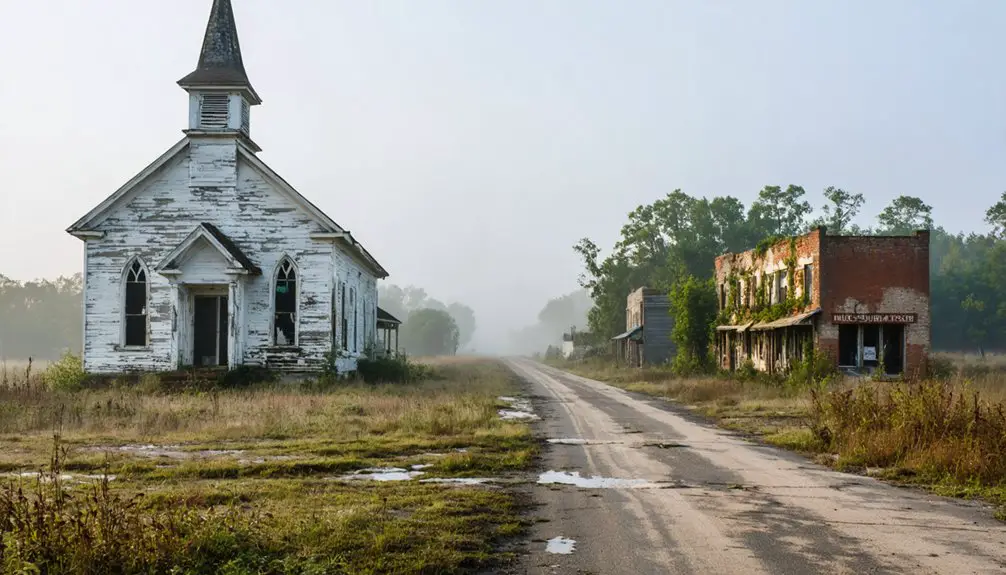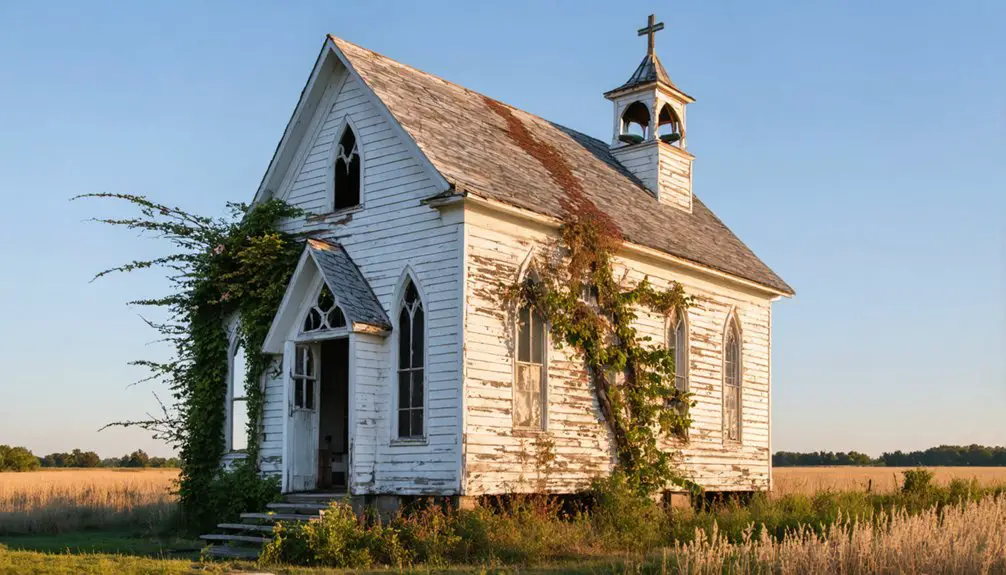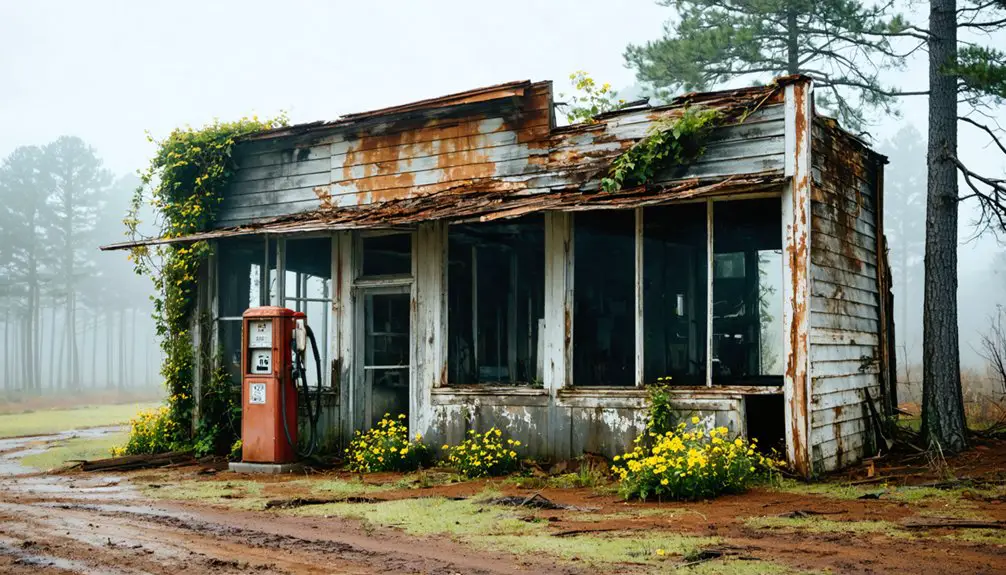You’ll discover Uniontown’s abandoned remains along Mississippi’s historic Natchez Trace, where this once-bustling 19th-century settlement thrived as an essential trading hub. The town’s strategic location connected river commerce with overland paths, serving countless travelers and traders. Disease outbreaks, economic hardships, and changing transportation routes eventually led to its decline. Today, its silent streets and forgotten foundations tell compelling stories of frontier life, Native American connections, and the rise and fall of early American settlements.
Key Takeaways
- Uniontown evolved from a Native American trail hub into a significant trading post along the Natchez Trace during the early 1800s.
- The town’s strategic location between Nashville and Natchez made it crucial for river-based commerce and overland trade routes.
- Economic prosperity peaked with the arrival of the Alabama and Mississippi Railroad in 1857 and establishment of cotton facilities.
- Multiple factors led to decline: yellow fever outbreaks, bypassing railroads, boll weevil devastation, and the Great Depression.
- The town’s abandonment resulted in closed stores, schools, and services, transforming it into a ghost town with archaeological significance.
The Rise Along the Natchez Trace
While the Natchez Trace began as an ancient network of Native American trails spanning over 10,000 years of indigenous history, it evolved into an essential federal route that gave birth to settlements like Uniontown.
You’ll find its late 18th-century founding perfectly timed with the transformation of the old footpath into a major thoroughfare. Similar to other towns requiring place name clarification, Uniontown’s historical records needed careful organization to distinguish it from other settlements sharing the name. The settlement patterns along the trace shifted dramatically as British settlers established peaceful cultural exchange with Native Americans, and the federal government improved the route with bridges and causeways.
By 1809, wagon travel northward typically took two to three weeks along the improved route.
Uniontown’s strategic location served both travelers and new settlers pushing into former Choctaw and Chickasaw territories after the 1816 treaties.
The town’s main street, which still parallels the historic trace, became a bustling corridor of commerce and community life.
Trade Routes and Economic Growth
You’ll find that Uniontown’s position along major trade routes made it an essential link between river-based commerce and overland paths, including connections to the Natchez Trace.
Early traders established patterns of floating goods downstream on flatboats to New Orleans, then returning north on foot or horseback through these inland corridors. The development of steamboat transportation in 1811 revolutionized how merchants moved goods through Uniontown’s trading networks.
The emergence of Uniontown as an official government trading center strengthened regional commerce by providing a structured marketplace where Native Americans, settlers, and fur traders could conduct business.
Natchez Trace Trading Hub
During the late 18th and early 19th centuries, the Natchez Trace emerged as an essential 450-mile trade corridor connecting Nashville’s Cumberland River settlements to Mississippi River ports in Natchez.
You’ll find this route was crucial to early Natchez commerce, facilitating movement of goods, livestock, and tragically, enslaved people between the eastern states and Deep South.
The trading dynamics along the Trace supported a network of “stands” – basic inns serving travelers and merchants. The route’s proximity to Forks of the Road made it a key pathway for the second busiest slave market in the Deep South from 1832-1863. Enslaved people endured a brutal journey known as the Slave Trail of Tears as they were forcibly marched down the Trace.
When designated as a National Post Road in 1800, the federal government recognized its strategic importance for trade and military logistics.
However, by 1816, the Trace’s prominence declined as steamboat traffic and rival roads emerged.
This shift in transportation methods fundamentally changed how goods moved through the region, marking the end of the Trace’s golden era.
Early Commerce Patterns
Three major transportation developments transformed Uniontown’s early commerce patterns from a frontier outpost into a thriving regional hub.
You’ll find the 1848 plank road to Demopolis marked the first breakthrough, followed by the Alabama and Mississippi Railroad’s arrival in 1857, and additional rail connections to Louisville and Meridian-Jackson by 1905.
The commercial evolution centered around cotton, with early merchants establishing crucial trade infrastructure:
- Cotton processing facilities, including the Uniontown Cotton Oil Company (1897)
- Four prominent stores owned by Viverett, Lewis, Cleveland, and Portis
- Department stores along main street serving daily needs
- Peoples’ Bank (1919) providing essential financial services
Originally known as Woodville until 1861, the town underwent significant economic and infrastructural changes during its early development period.
These developments shifted trade from river-based commerce to an integrated network of rail and road systems, expanding Uniontown’s economic reach throughout the region.
Unlike many Mississippi counties of the era, the area focused on grain production rather than solely relying on cotton cultivation.
Native American Connections
Long before Uniontown existed, Native American peoples built impressive earthen mounds throughout the region, establishing a rich cultural legacy that spans over two millennia.
You’ll find evidence of this cultural heritage in the diverse mound types – from dome-shaped burial sites to flat-topped ceremonial platforms that once hosted tribal elites and important gatherings.
The Choctaw people particularly shaped this area’s history through their extensive trade networks, linking coastal shells to interior goods.
Even after the devastating Indian Removal Act of 1830, which forced most Choctaw from their ancestral lands, archaeological findings continue to reveal how native communities masterfully used local resources.
They’d gather nuts for processing, hunt seasonally in the Black Prairie, and maintain year-round villages to protect their crops.
Around 5,000 Choctaw people made the brave decision to stay in Mississippi as state-granted citizens, though they faced significant discrimination and legal challenges.
Many of these sacred sites were once abundant, but hundreds of mounds have disappeared due to erosion, agricultural development, and looting over time.
Life in Early Uniontown
As native peoples gave way to new settlers, Uniontown emerged along Cole’s Creek near Natchez in 1781 when pioneering families first carved out their homes from the Mississippi wilderness.
You’d find these early settlers facing numerous challenges while building a vibrant community centered around farming and river trade.
Life in early Uniontown revolved around:
- Working the rich soil to grow cotton and other crops, processing harvests at local gins
- Traveling to Natchez by oxen team to sell goods at market, often battling difficult terrain
- Gathering at Presbyterian and Baptist churches that served as both spiritual havens and community centers
- Teaching children in gender-separated schools, with some Scottish immigrant families maintaining their Gaelic traditions
These settler challenges forged strong community traditions that shaped Uniontown’s character through its early years. The town’s progress accelerated significantly with the arrival of the Alabama and Mississippi Railroad in 1857.
The Path to Abandonment

You’ll find that Uniontown’s downward spiral began as economic forces undermined its viability, with the decline of the Oregon-California Trail reducing essential commerce and government policies destabilizing local Native American communities.
The town’s traders and residents gradually departed as competing settlements drew away business, while administrative failures in governing the consolidated Potawatomi bands weakened the community’s foundation.
Those who remained watched their once-promising trading post fade into obscurity, as nearby Plowboy’s eventual disappearance in the 1880s marked the final chapter of this failed government experiment.
Economic Forces Drive Decline
The devastating combination of natural resource depletion and economic calamities pushed Uniontown toward abandonment during the late 1920s and early 1930s. You can trace the town’s economic decline to several interconnected factors that left the community with few options for survival:
- The timber collapse hit first, as vast longleaf pine forests were depleted and major lumber companies dismantled their operations, eliminating 24,000 jobs statewide.
- Agricultural disaster struck when the boll weevil devastated cotton crops, forcing many farmers to forfeit their land for unpaid taxes.
- The Great Depression delivered the final blow, shuttering 1,800 retail stores and reducing bank deposits by half.
- Without economic diversification or adequate infrastructure, Uniontown couldn’t attract new industries to replace lost jobs, triggering a mass exodus of residents.
Population Gradually Fades Away
Once Uniontown’s economic foundations crumbled, its population decline followed a gradual but relentless pattern spanning several decades.
You can trace the demographic changes through multiple factors that slowly chipped away at community resilience. Yellow fever outbreaks in nearby towns sparked the first waves of departures, while the rise of railroads bypassing Uniontown’s location dealt another blow to its sustainability.
Environmental challenges and flooding risks in the broader region made folks think twice about staying put.
As families moved away one by one, you’d see essential services like schools and stores shutting down, making life harder for those who remained.
The town’s fate wasn’t sealed in a single moment – instead, you’re looking at a slow exodus that eventually turned this once-vibrant community into a ghost town.
Historical Significance Today
Standing as a tribute to Mississippi’s dynamic past, Uniontown’s remnants serve multiple vital roles in modern historical preservation and education.
You’ll find this ghost town deeply woven into the fabric of regional identity, offering tangible connections to the state’s rich cultural heritage and economic evolution.
- Archaeological studies of building foundations and artifacts provide significant insights into 18th and 19th-century settlement patterns.
- Local heritage organizations use the site for cultural preservation, incorporating it into historical tours and heritage trails.
- Universities conduct fieldwork here, making Uniontown an outdoor classroom for hands-on historical research.
- The town’s remains serve as physical evidence of the shift from river-based commerce to modern economic systems.
These preserved ruins continue telling stories of Mississippi’s past, enriching our understanding of early American life.
Legacy of a Lost Settlement
Within Mississippi’s rich tapestry of abandoned settlements, Uniontown’s story represents more than just faded memories and crumbling foundations – it embodies a profound tale of environmental vulnerability and socioeconomic transformation.
You’ll find its legacy echoed in the broader pattern of ghost town exploration throughout the region, where river towns succumbed to nature’s power and changing transportation routes.
Like nearby Rodney, which nearly became the state capital, Uniontown’s decline mirrors a common trajectory: thriving river commerce gave way to devastating floods and economic upheaval.
Today, cultural preservation efforts keep these lost settlements’ stories alive through photography, historical documentation, and oral histories.
The ancient Native American mounds nearby remind you that this land has witnessed countless cycles of settlement and abandonment, making Uniontown’s story part of a much longer human narrative.
Frequently Asked Questions
Are There Any Surviving Photographs of Uniontown From Its Active Period?
Despite scouring the historical documentation like you’d Google-search your ex, you won’t find surviving photographic evidence of this town’s glory days – neither in public archives nor private collections.
What Natural Disasters, if Any, Contributed to Uniontown’s Decline?
You’ll find devastating tornadoes, including EF3-5 storms, and major Mississippi River flooding repeatedly hammered the region, destroying farms and homes while accelerating the town’s economic decline through persistent natural disaster damage.
Were There Any Notable Crimes or Lawlessness in Uniontown’s History?
While outlaws terrorized nearby Rodney, you won’t find specific crime incidents documented in Uniontown’s history. Local law enforcement records are scarce, though regional Civil War conflicts likely affected the community.
What Happened to the Cemetery and Burial Grounds of Uniontown?
You’ll find the cemetery’s history reflects tough preservation challenges, with many markers lost to time and nature. While some burial site restoration efforts exist, steep terrain and overgrowth continue threatening these sacred grounds.
Did Any Famous Historical Figures Ever Visit or Stay in Uniontown?
Like faded footprints in forgotten sands, you won’t find records of any famous historical visits or notable residents in Uniontown’s past. Research shows no documented stays by prominent figures there.
References
- https://octa-trails.org/wp-content/uploads/2023/05/Ellis-Uniontown-and-Plowboy–-Potawatomi-Ghost-Towns.pdf
- https://www.onlyinyourstate.com/experiences/mississippi/ms-ghost-towns
- https://theforgottensouth.com/rodney-mississippi-ghost-town-history-tour/
- https://backroadplanet.com/haunting-rodney-mississippi/
- https://dbpedia.org/page/Uniontown
- https://en.wikipedia.org/wiki/Natchez_Trace
- https://en.wikipedia.org/wiki/Uniontown
- https://npshistory.com/newsletters/regional_review/vol2-4d.htm
- https://www.nps.gov/natr/learn/historyculture/index.htm
- https://natcheztrace.org/history-of-the-natchez-trace/



